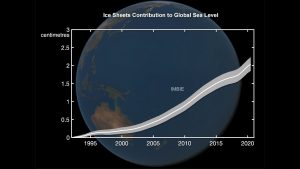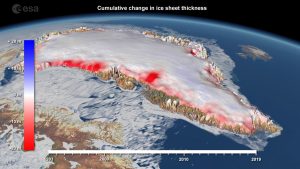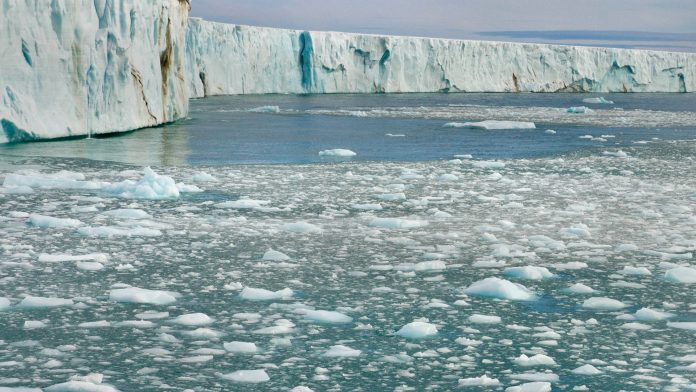Over the last decade, polar ice sheet melting records have faced their seven worst years, with 2019 being the worst on record.
According to IMBIE, an international team of researchers who have combined 50 satellite surveys of Antarctica and Greenland taken between 1992 and 2020, ice sheet melting now accounts for a quarter of all sea level rise – a drastic fivefold increase since the 1990s.
A paper detailing the research, ‘Antarctic and Greenland Ice Sheet mass balance 1992-2020 for IPCC AR6,’ is available to view on the British Antarctic Survey website.
Using satellites and space technology to observe the rate of ice sheet melting
An increase in global heating has led to a huge drive forward in ice sheet melting records, and in turn, increasing sea levels and coastal flooding around our planet. Ice losses from Greenland and Antarctica can now be reliably measured from space by tracking changes in their volume, gravitational pull, or ice flow.
To fund these projects, NASA and the European Space Agency (ESA) awarded funding to IMBIE, which is led by Northumbria University’s Centre for Polar Observations and Modelling, in 2011. With this funding, the team has been collecting satellite record data of polar ice sheet melting. The data collected by the team is widely used by leading organisations, including the Intergovernmental Panel on Climate Change (IPCC).

In their latest assessment, the researchers have combined 50 satellite surveys of Antarctica and Greenland to measure the rate of ice sheet melting.
The melting rates are alarming
Altogether, the polar ice sheets have lost ice every year on satellite record, and have also faced their seven highest melting years in the past decade. In 2019, which was a record melting year, the ice sheets lost an alarming 612 billion tonnes of ice.
This loss was driven by an Arctic summer heatwave, which led to record ice sheet melting from Greenland, peaking at 444 billion tonnes that year. Moreover, Antarctica lost 168 billion tonnes of ice – the sixth highest on record – due to the continued speedup of glaciers in West Antarctica and record melting from the Antarctic Peninsula. However, the East Antarctic Ice Sheet remained close to a state of balance, as it has throughout the satellite era.

In the early 1990s, ice sheet melting accounted for only a small fraction (5.6 %) of sea level rise. However, there has been a fivefold increase in melting since then, and they are now responsible for more than a quarter of all sea level rise.
If the ice sheets continue to lose mass at this pace, the IPCC predicts that they will contribute between 148-272mm to the global mean sea level by the end of the century.
How can we prepare for the risks associated with this melting?
Professor Andrew Shepherd, Head of the Department of Geography and Environmental Sciences at Northumbria University and founder of IMBIE, stated: “After a decade of work, we are finally at the stage where we can continuously update our assessments of ice sheet mass balance as there are enough satellites in space monitoring them, which means that people can make use of our findings immediately.”
Dr Inès Otosaka from the University of Leeds, who led the study, added: “Ice sheet melting in Greenland and Antarctica has rapidly increased over the satellite record and is now a major contributor to sea level rise.
“Continuously monitoring the ice sheets is critical to predict their future behaviour in a warming world and adapt for the associated risks that coastal communities around the world will face.”
Over the past few years, ESA and NASA have made a dedicated effort to launch new satellite missions capable of monitoring the polar regions. The IMBIE project has taken advantage of these to produce more regular updates, and, for the first time, it is now possible to chart polar ice sheet losses every year.
This is the third assessment from the IMBIE team and involved 68 polar scientists from 41 international organisations using measurements from 17 satellite missions. Importantly, it brings the records of ice sheet melting from Antarctica and Greenland in line, using the same methods and covering the same period in time. The assessment will now be updated annually to make sure that the scientific community has the very latest estimates of polar ice losses.
“This is another milestone in the IMBIE initiative and represents an example of how scientists can coordinate efforts to assess the evolution of ice sheets from space, offering unique and timely information on the magnitude and onset of changes,” said Dr Diego Fernandez, Head of Research and Development at ESA.
He concluded: “The new annual assessments represent a step forward in the way IMBIE will help to monitor these critical regions, where variations have reached a scale where abrupt changes can no longer be excluded.”









